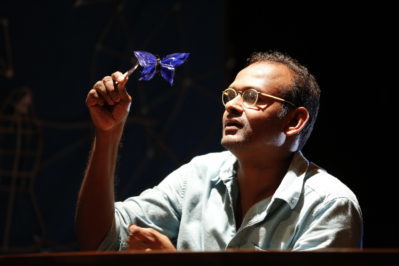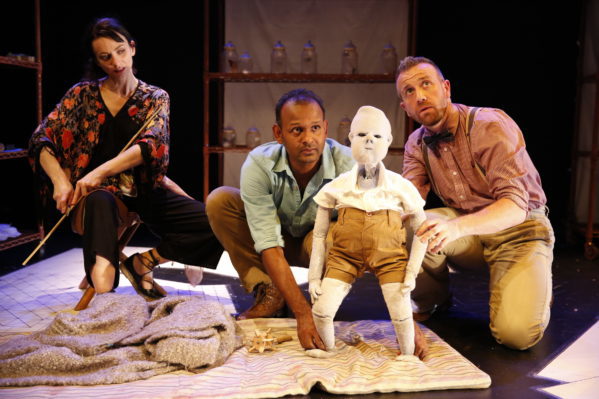INTERVIEW: New play reimagines ‘Madame Butterfly’ at 59E59

Butterfly, which will finish up its run at 59E59 in New York City Saturday, May 14, is a wordless retelling of the famous Madame Butterfly story. The performance, from Scotland-based Singaporean Ramesh Meyyappan, uses visually poetic narrative and handcrafted puppets to bring the tale and its characters to life.
Meyyappan stars in the piece, along with Naomi Livingstone and Chris Alexander. Butterfly previously played 2015’s Edinburgh Festival Fringe.
The story is a classic one, involving the love and disappointment of a lonely kitemaker pulled between attachment and isolation.
Recently, Hollywood Soapbox exchanged emails with Meyyappan, whose credits also include Snails & Ketchup. Questions and answers have been slightly edited for style.
How did the idea to adapt Madame Butterfly originally begin?
My initial encounter with the story was in a beautifully illustrated book abridged version. Quite possibly the images from the book captured my imagination and stirred some emotion that allowed me to pursue reading the original version of the story (not the opera — although I did look at various version[s] of this).
Thereafter I read the short story by John Luther Long — thoughts from this included cultural differences and the different expectations between men and women, the trust from a woman and her betrayal and disappointment.
However, the most powerful image created when reading was how her child was taken from her — evoking much emotion based on her loss. It was this final image / thought that really inspired a desire to create Butterfly. In life most of us will suffer some form of loss — it has various guises and impacts on us at different levels. This seemed like a ‘theme’ worth exploring, one that was universal and one that would almost definitely evoke some empathy.
There became a sense of wanting to explore how grief and loss manifest themselves both physically and emotionally. I do understand the loss of a child, and it cannot be fully explained in words — the emotion is intense and overwhelming. It can and does impact on daily life and can make life itself difficult. This is a huge part of Butterfly.

What is your main goal with the theatrical piece? What would you like audience members to learn?
With most of my work I aim to create stories that speak to everyone, that have shared and universal themes and ideas, that folk wherever they stay and whoever they are (class, race, gender, ‘ability’) will get something from or will relate to. Butterfly was no different.
The challenge and aim for me when creating work is finding the common ground, not just in the themes and ideas but also in the language — finding that shared language.
Theatre has its own language and traditions; what I aim for is looking at that language — the visual one that exists and taking it one step further, combining a host of visual ideas to create something that is universally shared and understood. I always hope that the language used is open to interpretation from individual audience members while still managing to convey the story and character journeys.
With Butterfly I hoped that audiences would relate in some way to the characters and to parts of the story itself; whether that is the relationships and their changing dynamic or the more serious sense of trauma and loss, and how that impacts on our emotional, mental and even physical well being.
Could you elaborate on the creative process of bringing Butterfly to life? What went into the selection of movements and visuals to tell the story?
Butterfly was always going to be about the mother / son relationship and the loss of this child, the grief that descends thereafter. In Butterfly there had to be ambiguity about the child. She suffers the loss during pregnancy, and the trauma of that and the ‘other’ trauma she suffers means her mind takes her to a place where the child is with her. For audiences to understand this we needed to consider the world of her grief as almost unreal — not the reality that we all live in and so that had to be shown somehow on stage — the child had to be real to her but clearly not to the audience — the use of puppets made this entirely possible.
Gavin Glover spent some development time with me and an actor to explore this aspect, as it was central to the story we had to get this right and the exploration allowed us to do this — Gavin understanding what the puppets’ role was and the relationship it had to have with Butterfly and with the audience was crucial in him designing and making our puppet boy.
I was also put in touch with a dramaturg with NTS — they engaged in a dialogue with me about a visual script I wanted to develop for Butterfly. Scripts tend to do more than just say what happens on stage, but when what you are creating is visual, it is a challenge to create all of the subtleties and potentially visual motifs within the script. I’m very proud of the script itself, having written it myself it may seem cheeky to say that it reads like poetry — at least to me it does, and I do think it really helped the whole production team and the actors themselves to get a real sense of the story and what had to be communicated.
While writing and creating Butterfly, I took a genuine interest in butterflies themselves, and I do think that we created some interesting theatrical motifs that are inspired by these and help us tell the story. I was struck by their colours, movement and the very delicate nature of butterflies. This led me to become interested in Lepidoptery and Vladimir Nabokov (although known for his writing including the modern classic Lolita). Nabokov influenced the creation of one of the male characters — he had a love of butterflies entirely appreciated their beauty, but he also captured these which ultimately meant killing them — this dichotomy was also an idea I wanted to explore.

What do you see in this main character, Butterfly, that is so important to build a theatrical piece around? What are some of her qualities that you enjoy sharing with the audience?
Reading the story I was struck by her resilience, sticking out the tough times and determined to make things work for her and her child … obviously the known ending of the original ends in tragedy for her, and it seemed no matter how hard she fought, this was one battle she wasn’t going to win.
I wanted to show Butterfly’s strengths initially; her warmth, sense of herself and her independence and her inner and natural beauty. I think we all have vulnerable sides. Butterfly becomes vulnerable only when others force her into painful situations. I really don’t see Butterfly as being weak when she suffers incredible loss — unimaginable loss and trauma, that she demonstrates that grief (manifested in the imagining of a life with a child) only shows a very real human side and far from a romanticized notion of tragedy … rather it’s dark and horrific, just as grief can be.
How was this piece received at the Edinburgh Fringe in 2015?
Being part of both the British Council Showcase and Made In Scotland helped to give me faith back in what I do, provided some confidence going into the Fringe, there was also a sense of achievement — recognition always brings that. Having Butterfly selected to be part of both these programmes was great for us as a team.
The piece was well received by critics and audiences — I’d meet audiences (both new and old) and they had never seen this kind of theatre before. It is a mutual feeling from American audiences — I was approached by both deaf and hearing audiences — the images remained in their heads.
Butterfly managed to develop new audiences — that crossover audience, traditional theatregoers who enjoy the ‘classics’ that the original Madame Butterfly is, audiences who enjoy innovative / new work and those who have a specific interest in puppetry or visual as well as the deaf audience. A challenge to appeal to such a wide spectrum, but one that there is evidence of relative success, certainly from media and reviews.
What’s your anticipation for the American engagement at 59E59? Do you think different audiences respond in unique ways to theater?
This run at 59e59 brings an element of the unknown to me, and all I can do is let the work speak for itself rather than think of what to expect from an audience.
I do try and create work (as I’ve said earlier) that speaks to as wide an audience as possible, using a universal, shared language. … I just cross my finger that [the] audience [members] ‘get it’.
By John Soltes / Publisher / John@HollywoodSoapbox.com
Butterfly is currently playing 59E59 at 59 E. 59 St. in New York City. Click here for more information.

